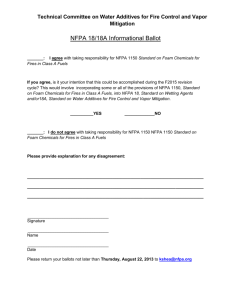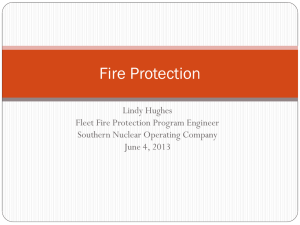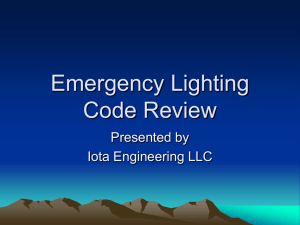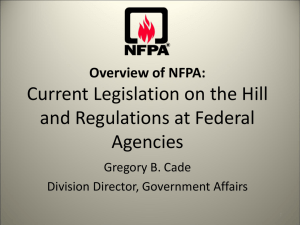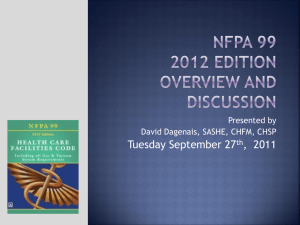Word - National Fire Protection Association
advertisement
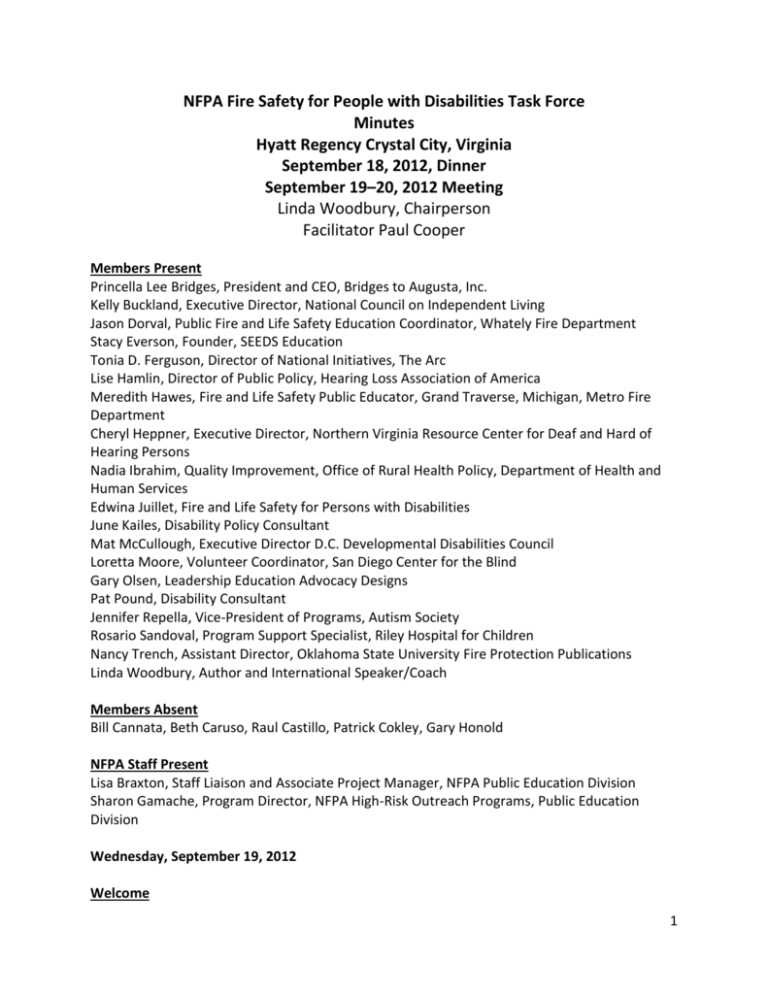
NFPA Fire Safety for People with Disabilities Task Force Minutes Hyatt Regency Crystal City, Virginia September 18, 2012, Dinner September 19–20, 2012 Meeting Linda Woodbury, Chairperson Facilitator Paul Cooper Members Present Princella Lee Bridges, President and CEO, Bridges to Augusta, Inc. Kelly Buckland, Executive Director, National Council on Independent Living Jason Dorval, Public Fire and Life Safety Education Coordinator, Whately Fire Department Stacy Everson, Founder, SEEDS Education Tonia D. Ferguson, Director of National Initiatives, The Arc Lise Hamlin, Director of Public Policy, Hearing Loss Association of America Meredith Hawes, Fire and Life Safety Public Educator, Grand Traverse, Michigan, Metro Fire Department Cheryl Heppner, Executive Director, Northern Virginia Resource Center for Deaf and Hard of Hearing Persons Nadia Ibrahim, Quality Improvement, Office of Rural Health Policy, Department of Health and Human Services Edwina Juillet, Fire and Life Safety for Persons with Disabilities June Kailes, Disability Policy Consultant Mat McCullough, Executive Director D.C. Developmental Disabilities Council Loretta Moore, Volunteer Coordinator, San Diego Center for the Blind Gary Olsen, Leadership Education Advocacy Designs Pat Pound, Disability Consultant Jennifer Repella, Vice-President of Programs, Autism Society Rosario Sandoval, Program Support Specialist, Riley Hospital for Children Nancy Trench, Assistant Director, Oklahoma State University Fire Protection Publications Linda Woodbury, Author and International Speaker/Coach Members Absent Bill Cannata, Beth Caruso, Raul Castillo, Patrick Cokley, Gary Honold NFPA Staff Present Lisa Braxton, Staff Liaison and Associate Project Manager, NFPA Public Education Division Sharon Gamache, Program Director, NFPA High-Risk Outreach Programs, Public Education Division Wednesday, September 19, 2012 Welcome 1 Linda opened the meeting at 8:50 a.m. by welcoming everyone and thanking them for making the trip. She said that this meeting was a priority because it means saving people’s lives. Linda announced that she is the new chair of the Fire Safety for People with Disabilities Task Force and that Michael Collins, former chair of the Task Force, had received the High-Risk Outreach Award from NFPA. Linda asked if the members’ accommodations were okay. Someone mentioned that there was a little problem with e-mail and Internet. Princella said that there should be better handles on the drawers in the sleeping rooms so people like her could use them easily. Gary said that NFPA should negotiate with the hotel for free Internet access. However, Linda said that the access was free to members and that the charge would be taken off the bill when everyone checked out. Everyone introduced him- or herself, and Paul Cooper introduced himself as the facilitator. Linda asked if the minutes from the last meeting were acceptable. Edwina made a motion to accept the minutes, and Loretta seconded the motion, which passed unanimously. Linda announced that there would be a special presentation on Thursday in memory of the late Bill Scott, who was a member of the Task Force, and thanked NFPA staff for putting the group together and taking the initiative to make sure that NFPA pays attention to the needs of people with disabilities. She said that as the world grows, it will become natural to include people with disabilities in all facets of life. Paul reviewed the agenda with the group. History of the Task Force Linda then gave a brief history of the Task Force. She spoke of the Solutions 2000 and Beyond Solutions 2000 symposia held in 1999 and 2000 respectively. These meetings, sponsored by several organizations including the NFPA Center for High-Risk Outreach, brought together the fire service and the leaders of organizations dedicated to serving people with disabilities, as well as people who work with older adults and young children. Sharon said the leaders at the symposia thought that those in the fire safety field paid quite a bit of attention to the needs of young children and older adults but that there was a gap in the attention for people with disabilities. To address the recommendations developed at the Solutions 2000 and the Beyond Solutions 2000 meetings, the NFPA Center for High-Risk Outreach organized another meeting in 2002 in Washington, D.C., of leaders of people with disabilities called Focus on Fire Safety for People with Disabilities. In 2003, NFPA and Oklahoma State University Fire Protection Publications sponsored another meeting in San Diego. After the meeting was over, there was a major wildland fire in California. Although the local news stations covered the fire, the information they gave was not accessible 2 to everyone, including Linda. Linda went to a local shelter and brought two couples to stay at her home; they saw pictures and words scrawling on the TV that she could not otherwise access. They read the information and described the pictures and locations to her. At its next meeting, held in Long Beach, California, in 2007, the Task Force revised the Criteria for Evaluating Public Education brochures. Task Force members have been guest speakers at the NFPA Conference & Expo and state seminars. Loretta was on the Task Force for review of general information, and Linda put together a report addressing ways to make sure that children with disabilities would be included in classroom activities. Edwina added some early historical information, noting that a lot of baby steps led up to the Solutions 2000 meetings. Among other things, NFPA started to look at the egress issues in the codes and standards for employees in their place of work in the late 1970’s after realizing that people with disabilities needed to be included in fire evacuation plans. Nancy Trench said that she met Stacy Everson at the San Diego meeting and later submitted a grant proposal with SEEDS as a subcontractor to provide a fire safety program for people with developmental disabilities who live on their own. SEEDS now uses Oklahoma State University as a subcontractor for its grant activities. Edwina added that another milestone was a chapter dealing with people with disabilities in the NFPA 101©, Life Safety Code©. This was the first code chapter addressing this issue, and June said that the Task Force went over all the materials for sensitivity and cultural neutrality and appropriateness many times. Gary suggested adding personal stories to the history in future editions of the code, and Sharon said that some could be included. Staff Liaison Report Lisa Braxton gave a presentation on NFPA materials for people with disabilities that had been developed since the last Fire Safety for People with Disabilities Meeting in 2010. She showed the landing pages for the Fire Safety for People with Disabilities web materials and noted that, as part of the meeting, participants would discuss how to reconfigure the information on the landing page. Representatives from the Task Force have been involved in the NFPA Conference giving presentations on disability related issues. Lisa listed all of the presentations that members have done at the conference in the past four years. Last year, Stacy Everson developed fire safety lessons for people with intellectual disabilities as part of the Fire Prevention Week materials under the category “populations that are high risk to fire.” All the materials were vetted for technical accuracy and were available for both the 2011 and 2012 Fire Prevention Week campaigns. In addition, Edwina wrote the text for a piece on mid-level and high-rise apartment safety for people with disabilities. 3 Lisa said that when the group met in Phoenix in 2010, someone recommended developing educational materials on the use of medical oxygen in the home. An oxygen safety tip sheet, free on NFPA’s website, was developed this year. The “Smoke Alarms for People Who Are Deaf and Hard-of-Hearing” tips sheet was also developed. In addition, Lisa discussed the Fire Safety for People with Disabilities brochure that NFPA sells. It was developed by NFPA’s Marketing Department, and Lisa and several people on the Task Force reviewed it for accuracy. It took some effort to get the dog in the illustrations to look like a guide dog. Lisa also noted that there was a Fire Prevention Week blog with posts over two to three months. She displayed blog posts she wrote on fire safety for people with disabilities and said she would write more blogs with input from the Task Force. Linda asked that NFPA make sure that all materials were ethnically diverse. Future Activities Mat said that drawings can only go so far and that photos would allow one to see the actual culture. Photos can be more accurate in depicting real people with disabilities. Stacy said that she finds that people with autism or developmental disabilities need both photos and artwork, and Jason Dorval agreed. Nadia agreed with Stacy, June, and Mat. She also noted that the service dog shown in the brochure didn’t really look like a service dog and that the brochure should take into consideration people with different reading levels. Pat said it would be good to show service dogs doing service tasks for people with disabilities other than blindness. Gary, who said that you can’t tell by looking at him that he is deaf, noted that the drawings in the brochure were cute, but he thought that photos would identify people better. Mat said that photos are much better at showing people who are deaf because they capture reality better. June said that when we do a collage of people, it is important to show people with visible disabilities and non-visible disabilities, adding that artwork or cartoons would work in something meant for children. Linda said that since there was a camera at the meeting, staff might be able to take some photos of people with disabilities that day and the next. Tonia wanted the group to look at the language used to describe educational pieces on the website. For example, she noted that the site said that the “I Know My Fire Safety Plan” 4 brochure was aimed at high-functioning children with autism. She said she would use it for a low-functioning child with autism. Some Task Force members wanted the social story to be converted into an iBook, the creation of an adult version of the story, the creation of projects for adults with autism and for lowerfunctioning people with autism, and access to the story for people who didn’t have computers. Pat Pound said that since the Task Force was creating materials for electronic media, it should think about how the electronic information shows up on mobile devices and it should look at apps. Loretta asked if developing refrigerator magnets had been explored. Mat asked if anyone from the deaf community had looked at the materials and wondered whether the words “deaf” and “hard-of-hearing” should be capitalized. He also said that only words “deaf” and “hard-of-hearing” should be used, not “people with profound hearing loss.” If you use the combination of “deaf” and “profound hearing loss,” people who are deaf would be upset. However, Nancy said that this language might be used in the fire codes and that NFPA is limited to using the code language. Sharon told the group that there may be more detailed descriptions regarding hearing loss in the fire codes but that the terms “deaf” and “hard-of-hearing” should be used for most educational purposes. June suggested developing a style sheet defining what language to use, particularly since many Task Force members were trained in the law and legal terms might not be appropriate for educational materials. The goal, she said, is communication. A suggestion was made to produce a social etiquette/style sheet for the fire safety educator community and to refer to Nancy Trench’s PowerPoint for reference. Lisa discussed the webinar on autism and the “I Know My Fire Safety Plan” autism interactive fire safety story. She also spoke about her three-year plan to reach more media sources with public education materials. Included in the plan is a section on reaching publications for people with disabilities. Linda suggested that the webinars, such as the one on autism, should be on the NFPA website or that a link to it should be developed for the website. Lisa said she would follow up on the suggestion. Paul read the charter for the Fire Safety for People with Disabilities Task Force and asked if the charter was appropriate. Pat thought that the charter seemed to relate to NFPA’s Public Education Division and that it didn’t say whether people could comment on other areas of NFPA than public education. 5 Gary noted in particular that we should go out of our way to provide such information for schools on our disability pages. Linda agreed, noting that information should go directly to schools during the weeks leading up to Fire Prevention Week. Linda suggested training people in other NFPA departments on disability issues. Jennifer noted that the Task Force charter was geared to providing NFPA’s Public Education Division with information from the Task Force but that it might be wise to include something about getting the information back to NFPA staff members. In a similar vein, Nancy thought it would be good for the members of the Task Force to know about the various NFPA committees and to learn how NFPA nominates people to the NFPA Board of Directors. Nadia said that it would be good to include in the charter something about ongoing training about fire safety and disability issues for individual Task Force members. New members in particular should be trained so they will have some knowledge when they come to the Task Force meeting. Paul asked about the responsibility of NFPA staff and about NFPA’s role in the Task Force. Someone suggested that NFPA staff update Task Force members between meetings so that members knew how NFPA took the Task Force’s input and followed up on its suggestions. Lisa informed the group that NFPA asks for feedback from the Task Force when it produces educational materials but that the Association does not regularly follow up with the group during the year. Cheryl asked whether the Task Force could meet more than once a year. Pat said she would like an update on hot issues, Lisa suggested that people go to NFPA’s Twitter and Facebook pages to get such information. Princella noted that the Task Force charter didn’t give its members a responsibility and suggested that members let NFPA know what they discover in the community. Edwina said that when she belongs to an organization, she wants to see how she fits in and suggested developing a written orientation for Task Force members that would answer such questions as “What is NFPA? What are its goals and objectives?” Loretta said that when NFPA staff members are in a Task Force member’s community, they could bring NFPA staff in for collaboration. Linda said that the Task Force should not bite off more than it could chew and that members needed to take responsibility for going on the website to see what was there. The group’s main role, she said, is to advise NFPA’s Public Education Division. Gary said that the group’s first goal should be to develop ideas and suggestions and that NFPA should get this information out. 6 June thought the Task Force should to be more of a liaison to NFPA’s Disability Access Review and Advisory Committee (DARAC) and to those who work on wildland fire issues. She said that there should be more communication between NFPA and the Task Force and that the Task Force should be a “force multiplier.” For example, anyone with a website could include information on the Task Force’s work. Sharon said that NFPA staff could give the wildland fire group information on reaching people with disabilities. Lisa said she would take all the input from the meeting back to NFPA staff. When someone asked whether NFPA responds to the Task Force suggestions, Sharon said that there was good response from the Public Education Division staff. June suggested that perhaps staff from other departments, such as Marketing, could, come to Fire Safety for People with Disabilities Task Force meetings. Edwina explained that DARAC was another volunteer group at NFPA that advised the Association on issues related to disabilities. DARAC was formed to develop public outreach efforts, as well as to provide input to disability-related provisions to NFPA’s codes and standards. Edwina felt that DARAC and the NFPA Fire Safety for People with Disabilities Task Force should remain two separate entities. Gary said that the Task Force’s purpose was to advise NFPA, not to analyze the whole system. Tonia said that one way to measure success was to see how many hits the fire safety for people with disabilities information on the website got. Lisa said she would research that information. June thought the Task Force’s statement of purpose should be a part of NFPA’s DNA and wanted to know how NFPA measures success. Nadia said she would like to look at outputs and outcome. For example, does the information make a difference at the state and local levels? She would like the Task Force to move beyond the number of brochures distributed to measure the impact of those brochures. Additional suggestions: Develop a comprehensive list of educational materials and links, updated by October 7. Use fire safety materials during certain months or at various events. Morph information into mobile formats. Develop short podcasts, webcasts, and various other formats to disseminate information. Customize outreach that can work on a wrist watch and coordinate fire messages for the audience. Blog during the upcoming Fire Prevention Week. Need ideas. 1. Wildfires (Mike Collins did a paper on wildfire with all the entities.) 2. Volunteer firefighters need to have 7 information about people with disabilities around their areas. 3. Think about standalone pieces for Twitter and Facebook. 4. Discuss shelter planning for people with disabilities. 5. Instead of using the term “disability indicators,” use the term “functional needs indicators.” 6. Using care providers to help with functional needs. 7. Using the experts at the meeting to write for the blog. 8. Have representatives go to organizations to discuss NFPA and link to them. 9. Link with care providers and have a liaison discuss NFPA. Send Task Force members a copy of the NFPA strategic plan or the Public Education Division’s strategic plan so that the Task Force can see if it’s on target. Have NFPA staff put together a list of resource materials for website links. Suggested Education sessions at the NFPA Conference & Expo: Caregiver training on EVAC chairs Multi-story building evacuation regulations for “areas of refuge” Evacuation from public transit Evacuation from unsprinklered group homes and dorms Evacuation of service animals Case studies such as the Austin event Member Presentation Princella discussed her experience as a burn survivor and spoke about her organization, Bridges to Augusta. She also shared her history of involvement with NFPA through her work with Maria Figueroa and the Home Fire Sprinkler Coalition. She said that she works to reach adults and children who share the information with their parents because when someone gets burned, it doesn’t happen just to the survivor but to the whole family. She said that the Bridges to Augusta organization is available to people of upstate South Carolina who have been treated at a burn center and returned home. Bridges to Augusta helps them get the information that will allow them to be successful when they return to their homes. Linda thanked Princella for her presentation and thought it should be shared across the web. Jennifer asked if one could retrofit one’s home with fire sprinklers, and Nancy said that Oklahoma State University had just done a retrofit for someone who uses a wheelchair. Nancy said she would share the information on the adaptation with the fire service. Loretta asked about the experience of people with disabilities with stoves fires. Often, the apparatus for turning stoves on are at the back of the stove rather than the front, and Loretta said she had written to some of the stove manufacturers. She wondered if anyone else had had any experience with that, and Princella told her that her stove has the knobs on the front. 8 Nancy says that there is technology where the stovetop does not get too hot, and Linda talked about her history retrofitting kitchens for people who are blind. Lise asked whether NFPA required municipalities to have fire sprinklers. Princella told her that NFPA is currently advocating for home fire sprinkler legislation for state and local jurisdictions. She said to visit www.firesprinklerinitiave.org to learn more. Member Presentation Jason Dorval, a firefighter/EMT and public fire and life safety educator for the Whately, Massachusetts, Fire Department, gave a presentation on autism response and education. He works with four towns and is a member of the Autism in Law Enforcement Education Coalition. His son has Down syndrome and autism spectrum disorder, which may present challenges in an emergency. Jason has a program of the Arc, which teaches autism awareness to EMS personnel and firefighters and is free for fire and EMS departments in Massachusetts. The program’s contents include emergencies, wandering and elopement, rescue from heights, and medical response. He also works with juvenile fire setters, especially those who have developmental disabilities. For his child, the family car is the special meeting place outside their home because it gives him a place to go to where he will feel safe. Questions: Rosario asked if there were stove covers that helped with children with autism. Jason said these covers don’t work with kids with autism because the kids are too smart and overcome them. However, there are switches you can turn off that can be installed in a cupboard. June asked about sheltering issues. Given the limits of emergency shelters, she wanted to know what he recommended for a child with autism. Jason said that he took his son to the shelter before an emergency occurred. He told her that parents should take pictures or videos of the shelter and tell the child that this was his or her second home. One should also make sure that the shelter has smaller spaces available so the child does not have to stay in big areas with lots of noise. Loretta asked how his son got to school, and Jason said he took a van. He said he tells the drivers about his son and his disability, and he trains bus drivers in his community. Sharon asked about how he reconciled using a vehicle as a meeting place when it is not a permanent place. Jason told her that when his son is home the car is always there. Thursday, September 20, 2012 9 Welcome Linda opened the second day of the meeting, welcomed everyone, and expressed her gratitude to everyone participating. Tribute Edwina presented a tribute about Bill Scott who was a member of the Fire Safety for People with Disabilities Task Force. She explained that Bill incurred the spinal cord injury in 1975. Edwina first met him in the late 1980's at an annual meeting of the PCEH Presidents' Committee on the Employment of the Handicapped, where she had just conducted a workshop on fire safety for persons with disabilities. Bill indicated an interest in getting involved with safety and codes and standards. Subsequently, he testified at Code Meetings on Accessibility, in particular, on the accessible means of egress. During the tribute she showed a photo of him and colleagues taken in July 1993. They had just completed four days of interviews of people with disabilities who had evacuated the WTC after the February 1993 bombing. Others shared their memories of Bill, as well. Members’ roles and responsibilities Task Force members listed these roles and responsibilities: Learn about NFPA, disabilities, and fire safety Ask NFPA for assistance Speak up when they see issues Take issues back to their communities Participate in other NFPA groups and committees Promote NFPA’s efforts and programs Future Activities Discussion of Criteria for Evaluating NFPA Public Education Brochures Sharon said that the title of this should be changed to “Criteria for Evaluating NFPA Public Education Materials,” since most of the materials are now on the website. Nadia added that all videos should be captioned and that NFPA 508 and WEC compliance should be added. June asked whether videos should also be signed, but Gary said sign language is not so much the answer. Lise thought some of the videos should be signed and that they should be closed-captioned. Sharon clarified that technical accuracy can also include accuracy of the way people with disabilities are shown and how the adaptive equipment is portrayed. Pat said there should be descriptions of scenes in the videos for people who are blind and that the videos should always use “people first” language. It is also important to update the language as it evolves. 10 Nadia said the materials should clarify what is meant by diversity and define certain terms, such as “demeaning.” Linda asked for clear description of pictures for audio, YouTube, and the like. However, Pat said that there is very little accommodation for audio description on YouTube. Sometimes the way the script is written will help with audio description. June thought the criteria piece was good but that it should be dated and designated a Fire Safety for People with Disabilities Task Force document. She also thought the language should be clearer and the audience broadened “beyond the choir.” It should have enough specific information. Mat asked whether NFPA receives any federal funding, and Sharon said it received some federal money but not a lot. He also said that terms of the ADA require a reasonable amount of accommodation. Lise said that, as far as captioning and providing transcripts were concerned, one had to pick one’s battles. Mat said that it is hard to show diversity accurately with artwork but photos make it easier. Nadia felt that other groups should use these criteria and that getting the criteria out to others was a way of measuring outcome. Tonia said that the criteria should be updated every year and reference the latest technology. Gary thought that perhaps everything the group develops should be open-captioned, since this would provide more education and awareness to the public. Lise agreed. Nancy said that her organization refers the fire service to the American Printing House for the Blind. This saves NFPA from reinventing the wheel. Pat said that one has to be careful about e-books because a lot of them don’t have the right technology. She also noted that it is hard to use an e-reader when there are “all caps” on headers. The Task Force asked that all Task Force members be sent a copy of the criteria for review. Review of NFPA Fire Safety for People with Disabilities web pages NFPA.org/Disabilities When Paul asked for comments and feedback on the web pages, Gary said that the pages were not user-friendly because they were crowded with too much information. Nadia agreed, saying that the eye is not directed to any one place. She also said that the navigation items should move to the left side. Lise said there should be fewer words, more white space, and larger print. 11 Stacy noted that SEEDS is now reformatting its web page to make it compliant with the 508 Section of the Disabilities Act. Nadia said she would like NFPA to take a step back and think about the audience for the web page. For example, she said she sees a lot about tips and that they should be categorized for the audience. Pat said a web site could be 508-compliant and still be unattractive. She also noted that PDF files are hard for people who are blind to use. People who are blind will not be able to use their readers to read scanned PDFs. She suggested going to www.JimThatcher.com for an online tutorial and a look at 508-compliance that is very good. Another organization called Mobility is also good at this. Cheryl said that when she looked at the disability landing page, she got lost because it didn’t speak to her as a person with a disability. Mat said that if NFPA were looking to redesign the web page, he has a good understanding of websites and would be glad to help if NFPA needs assistance. Someone asked how to get exposure for the materials NFPA is producing, and Pat said to cook up events and tweets about them. Someone also suggested putting an announcement in NFPA Journal. Stacy said one other way to get exposure that is popular is Facebook. SEEDS was to put up film bites. Lise mentioned that she had a magazine the Task Force could use to get information out. She also saId that her organization has a convention at which Task Force members could make up a panel. A number of participants thought that a style sheet would be a good idea. Jennifer said that they could have an exhibit at her organization’s conference and that her organization would comp an NFPA exhibit. Princella suggested sending someone from the National Council for Independent Living Centers as well. Nadia wondered whether it would it be easier for Task Force members to the make the contacts or would there be a benefit to have NFPA make contacts directly. Pat said that studies have shown that screen readers miss things on the right side of the page. Linda said that she would like people to keep in mind that everyone is part of the Task Force and that each member should be responsible for putting out a positive message. 12 Lise said that she couldn’t imagine anyone saying something negative about the group. She also said the Task Force had to be able to talk at its meetings and not disseminate information until it is ready. Stacy said that she gets things out through a newsletter but that there are a wide variety of ways to get the Task Force’s messages out, such as national and international newsletters and resource fairs. Jennifer said that her organization’s newsletter and social networking sites offer numerous opportunities to publicize NFPA materials for people with disabilities. Jennifer suggested contacting the Alzheimer’s Association, www.alz.org. The association, which has chapters around the country, got federal funding for safety initiatives and has presented the results on the website. Someone suggested asking people to report Google analytics for web posts, Facebook posts, tweets, and such to help determine the Task Force’s reach. Someone else suggested establishing a scholarship in Bill Scott’s name to assist a college student. Member Presentation Gary Olsen talked about the presentation he gave at the NFPA Conference & Expo in Las Vegas last June. People who are deaf or hard-of- hearing have communication issues in relationship to fires. He said that he had spoken to the fire and emergency services about the problem but that they don’t quite understand. Gary said that one of the most important parts of outreach to people with disabilities is the local community collaboration. Mat said that he was happy that Gary had given this presentation because he had just received an e-mail from the National Association for the Deaf asking whether FEMA had just adapted fire alarms guidelines. Nancy said that she would address Mat’s question in her presentation. Gary noted that strobe lights were not the only way to warn people of an emergency and better methods existed. Lise said that Verizon and AT & T had started rolling out a test to 9-1-1 and that she thought it would be a good idea to add the test to 9-1-1 information. There is also more technology, such as phones that sound louder. 13 Pat said she saw something on twitter about a bracelet that people who are deaf could use. It vibrates on the wrist when it detects sound. However, it is in the experimental stage now and not yet on the market. Tonia asked about open-captioning, saying that is should be used more often. The Task Force agreed that it would like to have more material about these issues to distribute at the local level. Member Presentation Nancy Trench gave a presentation on Oklahoma State University’s programs for people with disabilities, showing risk levels and a summary of who is at greatest risk to fire deaths. Nancy pointed out that in the NFPA state report, Washington D.C. has the highest fire death rate. When Nancy worked with focus groups of people with disabilities, she found that they did not understand that the purpose of smoke alarms was to wake a sleeping person. She also noted that NIST data says that people now have only three minutes to get out of a burning home. This is less time than in the past because our homes are now of lighter construction and materials that are in the home are more combustible. She noted that 520 HX square wave signal was no better and that high-pitched alarms are the least effective in waking people up. Alarms that use a parent’s voice to wake children are ineffective, as well. Tests done in the early 1990s using strobe alarms to wake people who are deaf and hard of hearing were flawed because they did not test for wakefulness when people were in a deep sleep. Strobe lights are effective when people are awake, and bed shakers are effective when people are sleeping. In Oklahoma, they are installing the Lifetone receiver, which vibrates a bed, and the Gentex alarm with strobes and a backup battery that lasts seven days. Every time the Lifetone alerts, it goes for two full minutes. Each alarm costs $160, but people can buy it through Oklahoma State University for $70. Nancy pointed out that smoke alarms that are more than 10 years old will not work with Lifetone because they don’t have the temporal three alarms. She told attendees that there is also a Safe Awake listed by ETL. To learn more about ETL go to intertek.com. Nancy said Oklahoma’s smoke alarm programs install the First Alert dual sensor, long-life battery alarm that one can test with a TV remote. However, these are no longer available. In her regular smoke alarm installation programs they are going to buy both ionization alarms with a long-life battery and photoelectric alarms with long-life battery and install them in the most appropriate locations in the home. Nancy noted that NFPA does not list any products. 14 Nancy also announced that Oklahoma State University has a brailler and it does Braille for fire departments. People asked for a copy of Nancy’s PowerPoint presentation. Paul asked for volunteers for the Task Force’s task group committees. The following are task groups and those who volunteered for them: Ideas for 2013 Fire Prevention Week and NFPA Conference & Expo Jason, Princella, Pat, Edwina, Linda Criteria Sheet June, Mat, Linda, Nadia Autism education piece Jason, Tonia, Bill, Stacy, Jennifer, Princella, Linda NFPA conference panels in June 2014 Loretta, June, Gary, Tonia, Pat, Linda Criteria/Style Sheet Nadia, June, Mat, Nancy NFPA staff will revise the NFPA disabilities landing page. Gary recommended moving next year’s Task Force meeting to Boston. NPFA staff will work on the dates and location. Paul invited the participants to give feedback on the meeting. Edwina said the productivity was extraordinary. Princella wanted to see the outcome of the committees’ work when the Task Force meets again. She would like to know what the committees did and where they have influence to get this accomplished. People were also impressed with the hotel staff. Lise thought the meeting was terrific and complimented Lisa. She also suggested that the Task Force use microphones at the next meeting, noting that staff had provided microphones after the meeting got started on Wednesday but that it would be good to have them at the beginning of the meeting. There was a “thank you” for the interpreters for the good job they did. Linda thanked everyone, saying, “Don’t let this be NFPA Wednesday and Thursday. Let this be NFPA every day.” 15 Edwina drafted Nancy to be on the criteria sheet task group. The meeting adjourned at noon on September 20th. 16
